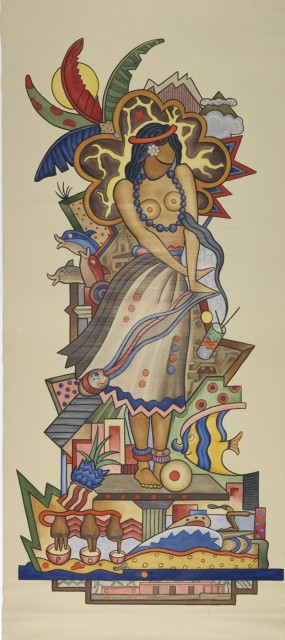This is one of six window shades created for the theatre in the Hollywood Wing of Duke Farms in Hillsborough, NJ. The theme of the six shades is music and dance which are all rendered in an art deco or cubist style. Each shade contains a central figure portraying a different country or region inspired by the classic four continents theme. While this shade portrays Hawaii, the other shades include Africa, China, Switzerland, Mexico and Russia. Each of the figures is surrounded by elements of folk tradition mixed with historic elements specific to that country or region. The Hawaii shade shows a female figure dancing the Hula on a pedestal. She is surrounded by tropical motifs including a palm tree, dolphins, pineapple, tropical fish, and volcanic mountains. Located beneath her are a figure on a surfboard and three bowls of poi. Hawaii is the birthplace of the hula dance and surfing. Poi is a food staple in Polynesia and is made from the underground stems or corm of the taro plant and is eaten with either one, two, or three fingers, depending on its consistency.
The original house on the estate dates to 1893 and was the home of James Buchanan Duke, who made his wealth in tobacco and hydroelectric power. Duke gained a competitive edge by being the first person to successfully use machines to roll cigarettes. In 1924, James established a $40 million trust called The Duke Endowment, with some of that money going to Trinity College. The college was then renamed Duke University in honor of James’ father Washington.
The Hollywood Wing of Duke Farms was added by daughter Doris Duke in 1938-39. The theatre was designed by Thomas W. Lamb, (1871-1942) one of the foremost theatre and cinema architects in the late 19th – early 20th century. He designed many of the most well-known theatres in New York City and across the country including the Ziegfield Theatre in 1927, Madison Square Garden in 1925, and the Academy of Music (later the Palladium Theatre) in 1927. The window shades are hand painted on canvas.
